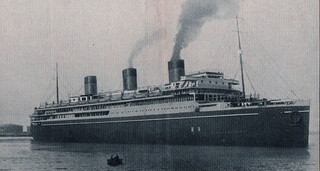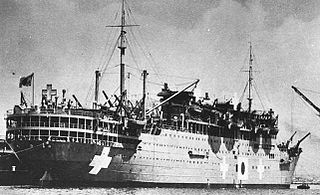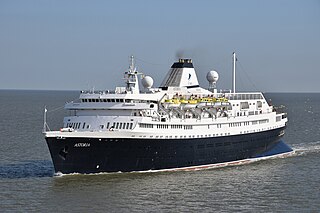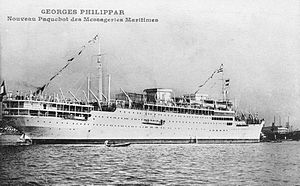
MS Achille Lauro was a cruise ship based in Naples, Italy. Built between 1939 and 1947 as MS Willem Ruys, a passenger liner for the Rotterdamsche Lloyd, it was hijacked by members of the Palestine Liberation Front in 1985.

An ocean liner is a type of passenger ship primarily used for transportation across seas or oceans. Ocean liners may also carry cargo or mail, and may sometimes be used for other purposes. Only one ocean liner remains in service today.

SS Commissaire Ramel was a French cargo liner that was launched in 1920 and sunk in the Indian Ocean by the German auxiliary cruiser Atlantis in World War II.

Selandia was the name of three ships of the Danish East Asiatic Company, the best known of which, the first MS Selandia of 1912, was the most advanced ocean-going diesel motor ship in her time.

SS L'Atlantique was a French ocean liner owned by the Compagnie de Navigation Sud Atlantique, a subsidiary of the Compagnie Générale Transatlantique (CGT). When completed in 1931 she was the largest, swiftest and most luxurious ocean liner on the route between Europe and South America.

Messageries Maritimes was a French merchant shipping company. It was originally created in 1851 as Messageries nationales, later called Messageries impériales, and from 1871, Compagnie des messageries maritimes, casually known as "MesMar" or by its initials "MM". Its rectangular house flag, with the letters MM on a white background and red corners, was famous in shipping circles, especially on the Europe-Asia trade lanes. In 1977 it merged with Compagnie générale transatlantique to form Compagnie générale maritime. In 1996 CGM was privatized and sold to Compagnie Maritime d'Affrètement (CMA) to form CMA CGM.

MS Aramis was built for France's Messageries Maritimes for the France-Southeast Asia colonial route. One of her distinguishing features was that her funnels were square-shaped. She was built to carry 1,045 civilian passengers in first, second, third, and steerage class. She was converted to an armed merchant cruiser when France entered World War II, until demilitarized following the Second Armistice at Compiègne on 22 June 1940. Aramis was seized by Japan in 1942, renamed Teia Maru (帝亜丸), and served as a repatriation ship in 1943. She served as a transport between Singapore and Japan in 1944 until sunk in the battle for convoy Hi-71 while assigned to the defense of the Philippines.

The Italian auxiliary cruiser Ramb II was a pre-war banana boat built at Monfalcone by the CRDA in 1937. She briefly served as an auxiliary cruiser with Regia Marina early in World War II before becoming an auxiliary transport with the Imperial Japanese Navy later in her career.

MV Astoria is a ship that was constructed as the transatlantic ocean liner Stockholm for Swedish American Line, and rebuilt as a cruise ship in 1993. Ordered in 1944, and commenced service in 1948, at 73 years old, she is the oldest passenger liner still sailing in deep water routes. As Stockholm, she was best known for an accidental collision with Andrea Doria in July 1956, resulting in the sinking of the latter ship and 46 fatalities off the coast of Nantucket, Massachusetts, United States.

SSCzar was an ocean liner for the then Russian American Line before World War I. In 1920-1930, the ship was named Estonia for the Baltic American Line, then named Pułaski for the PTTO and as a UK Ministry of War Transport troopship, and as Empire Penryn after World War II. The liner was built in Glasgow for the Russian American Line in 1912 and sailed on North Atlantic routes from Liepāja (Libau) to New York. On one eastbound voyage in October 1913, Czar was one of ten ships that came to the aid of the burning Uranium Line steamer Volturno.
Georges Philippar was a French shipbuilder. He joined the Messageries Maritimes company in 1912, becoming its chief executive officer in 1925.

Pieter Corneliszoon Hooft was a Dutch ocean liner built in 1925. An onboard fire destroyed her passenger accommodation before she was completed. In 1932, another fire damaged her so severely that she was sold for scrapping, only to catch fire again before she was scrapped.

HMT Empire Windrush, originally MV Monte Rosa, was a passenger liner and cruise ship launched in Germany in 1930. She was owned and operated by the German shipping line Hamburg Süd in the 1930s under the name Monte Rosa. During World War II she was operated by the German navy as a troopship. At the end of the war, she was taken by the British Government as a prize of war and renamed the Empire Windrush. In British service, she continued to be used as a troopship until March 1954, when the vessel caught fire and sank in the Mediterranean Sea with the loss of four crewmen. HMT stands for "His Majesty's Transport" and MV for "Motor Vessel".

Ateliers et Chantiers de la Loire (ACL) was a French shipbuilding company of the late 19th and early 20th century. The name translates roughly to English as "Workshops and Shipyard of the Loire".

MSC Preziosa is a Fantasia-class cruise ship owned and operated by MSC Cruises. She entered service in March 2013. She is an enhanced version of her first two class member ships, MSC Splendida and MSC Fantasia, and is identical to the previous MSC Divina. She debuted on 13 March as the fourth ship in the Fantasia class.

SS Patria was an 11,885 GRT French ocean liner built in 1913 for Compagnie française de Navigation à vapeur Cyprien Fabre & Cie, for whom she was first a transatlantic liner and then an emigrant ship. From 1932 Fabre Line leased her to Services Contractuels des Messageries Maritimes, who ran her between the south of France and the Levant. After the fall of France in June 1940 the British authorities in Mandatory Palestine seized her in the Port of Haifa and placed her under the management of the British-India Steam Navigation Company. In November 1940, the Zionist movement Haganah planted a bomb aboard which sank her with the loss of between 260 and 300 lives. Patria remained a wreck in Haifa port until she was scrapped in 1952.

RMS Otranto was an ocean liner that was built for the Orient Steam Navigation Company in 1925. The "RMS" prefix stands for Royal Mail Ship, as she carried overseas mail under a contract between Orient Line and Royal Mail. Otranto was in service until 1957, when she was sold for scrap.

SS Prins van Oranje was the second ship of the Willem III class. It was the first ship of the Stoomvaart Maatschappij Nederland (SMN) that completed a round trip to the Dutch East Indies.

SS Karnak was a French Passenger ship turned Troop transport that the German submarine SM U-32 torpedoed on 27 November 1916 in the Mediterranean Sea 70 nautical miles (130 km) south south east of Valletta, Malta. Karnak was carrying mostly troops from Marseille and Malta to Saloniki, Greece.
SS Viet-Nam was an Ocean Liner built in Dunkirk, France for Messageries Maritimes in 1953. Viet-Nam was built along with two sister ships, the SS Cambodge and SS Laos. She mainly provided passenger service between France, the Middle East, Southeast Asia, and Japan.



















